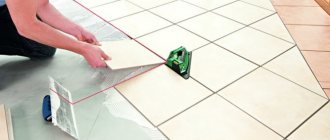Laminate flooring has been incredibly popular for several years now. It is no coincidence that this flooring has won the hearts of both ordinary apartment owners and construction business tycoons. It is distinguished by unsurpassed quality, wear resistance and attractive appearance.
Advantages and disadvantages
As you already understood, flooring laid diagonally can be used in rooms of any size, but in narrow rooms it plays the role of not only complementing the overall style, but also has the function of visually increasing its size. How it works? Let's take a closer look.
In a narrow space, the attention of guests and owners is concentrated on the floor, or more precisely on the direction of the slats. And in the case of diagonal masonry, everyone will consider the interesting arrangement of the pattern. This also applies to corners, which in the latter case can become the main accent in the interior.
Speaking about the disadvantages, it should be noted that this technique is characterized by a certain complexity. And quite a lot of material is consumed. Although a detailed study of the nuances of diagonal laying and a competent approach to the use of planks help to minimize the quantitative indicators of labor and material costs.
Process Features
To the question of how to lay laminate flooring diagonally, every professional has only one answer: easy and simple. Of course, only an experienced specialist can make the flooring original and attractive without much difficulty. But is it possible to do this kind of work yourself?
It must be said that the installation process is not much different from the classical technique. At the initial stage, it is necessary to level the surface and take care of the substrate.
The main criterion for choosing the direction of the dies is the level of natural light. Lay the laminate diagonally so that the sun's rays slide along the entire length of the laminate boards. This is necessary so that the glare playing on the floor distracts from the joints and seams, creating the illusion of the generality of the canvas.
Also, to ensure quality work, the following rules must be observed:
- Laying laminate flooring diagonally must be carried out under certain conditions. The room temperature should not be below 20 degrees, air humidity – 45-75%.
- One day before the start of work, the material must be removed from the packaging and laid out on the floor. This will help reduce the risk of deformation of the slats.
- To ensure proper engagement of the lock mechanism, use a wooden block (a rectangular block of wood).
- If desired, you can lay the boards from the middle of the room or from one of the corners. The first option, by the way, will help to significantly reduce the consumption of materials. If you start work from the center, you will have two spaces at your disposal, so a die that is not suitable on one side can be used on the other edge.
- It is necessary to lay the laminate diagonally one at a time, ending one row and starting another.
- Pay attention to the spacing of the seams. It is better to eliminate the defect immediately than to suffer over the dismantling of the laid dies at the end.
- If the gap between the wall and the last row is too large, insert wedges into the gap. But if in this case small defects can be hidden with the help of skirting boards, then defects near the doors are extremely difficult to hide.
It is precisely because of the possibility of gaps occurring near the entrance to the room that experts recommend installation without thresholds.
Two diagonal laying patterns
There are two ways to lay laminate diagonally: from the central axis of the room sequentially in both directions to the corners or from the far corner of the room through the center of the room to the opposite corner.
To work you will need:
- Jigsaw or hacksaw.
- Knife for opening packages.
- A steel bracket that allows you to fit the end of the last panel in a row. Without a bracket this will be very difficult.
- Plastic wedges. They are needed to maintain the distance between the panels and the walls.
- Roulette.
- Square.
- Mallet and die (for Lock locks).
- Pencil.
Choosing a laying angle
For diagonal laying, it is customary to start from an angle of 45° - this angle will allow you to use almost all sawn-off pieces of laminate during installation. There will be much less waste. However, there are times when the configuration of the room will dictate a different angle. Please note that an angle less than 30° will look bad. Acceptable angle sizes range from 30 to 45°.
Advice. Laying the laminate diagonally must be done with an assistant; it will be very difficult to do it alone.
From the center
With any installation method, work begins with installing plastic wedges around the perimeter of the room, which will remind you of the required distance between the flooring and the walls.
First, the first row of entire panels is assembled along the central diagonal axis of the room. The length of the last two pieces of laminate that will adjoin opposite walls in this row is measured from the end of the last intact panel to the plastic wedge. Save the remaining sections - they will fit on the other side of the row, and you will not need to saw the whole panel.
When the central row is laid, installation continues from it, first towards one corner, then the other. With an assistant, you can work in two directions simultaneously.
To install laminate in outer corners, you will need to mark three or more points on the panel. It’s more convenient to make a template and use it to saw off the panel to size. A piece of laminate cardboard packaging is perfect for a template. Or you can lay the coating tangentially to this outer corner.
Important! Laminate panels with a Click connection are inserted into the laid panels at a 45° angle, lowered and clicked into place. Before starting work, carefully check the possibility of laying the purchased model according to the “from the center” pattern. If the model you choose can only be laid in one direction, work will have to start from the corner.
After installation is completed, the plastic wedges are removed and the plinth is attached to the wall. Remember that laminate flooring is a “floating floor” and cannot be rigidly fixed. One more tip. Lay out the pieces remaining after cutting and try to use them in your work. Then even 10%!z(MISSING)apas will seem unnecessary to you.
We recommend: Step-by-step instructions for covering your house with siding yourself, photos and videos
From the corner
It is recommended to start laying from the corner with one whole panel. Both end sides are cut to the selected angle. The first whole panel (we consider it whole, it only has the ends trimmed) will set the direction for the entire floor.
Next, the installation continues towards the center of the room. We’ll leave the remaining corner for now; we’ll return to it later, using the remaining pieces of laminate.
To lay the laminate around the pipes, the panel is cut at an angle where the pipes pass, and cutouts are made in it using a drill to fit the pipes. It's even easier to make cutouts at the junction of two panels.
Laying the next row begins alternately with a whole panel or with half a panel if the floor covering is laid in a checkerboard pattern. When laying with an offset of a third of the board, the row begins with a whole board, the next one with a board 2/3 of the length, then a row with a panel 1/3 of the length. Then again the row starts with the whole panel. Both methods will not only make the coating neat and beautiful, but also increase its strength.
Important! Entire panels of one row are fastened at the ends. The length of the last two pieces of laminate that will adjoin opposite walls in this row is measured from the end of the last intact panel to the plastic wedge. Save the remaining sections - they will fit on the other side of the row, and you will not need to saw the whole panel.
You should be very careful to follow the direction of the tenon and groove in the row and in the panel you are going to cut. As the famous character of everyone’s favorite comedy movie said: “There’s no need to rush!” True, there they were talking about the return of a full-fledged member to society, and here - about the “fate” of one panel.
When the outer pieces for the next row are cut off, the entire already assembled row is removed from the connection with the adjacent one, completely assembled and only then finally fixed in the lock. It is for laying a long row that you will need the help of an assistant.
To cut panels intended for laying in the inner corners of the room, you will need to mark three points of the triangle. It’s more convenient to make a template and saw off the panel using it. A piece of laminate cardboard packaging is perfect for a template.
Features of diagonal laying without thresholds
For a neat floor design, it is best to use laying technology without thresholds and joints. To do this, it is necessary to change the flooring in two adjacent rooms. The absence of thresholds will allow you to erase the boundaries of rooms and create an overall design.
The combination of two types of finishing materials looks very nice. For example, a conditional boundary can be drawn by laying ceramic tiles in an adjacent room. This division is typical for the design of the hallway, kitchen and bathroom.
If, after finishing the work, you notice small gaps, they can be sealed with artificial cork. In terms of technical characteristics, it is similar to polyurethane foam, but the effect of its use is more attractive to the eye. Use a special gun to fill gaps. After treating the surface, take a break from working until the composition dries completely. After this, cut off the excess material.
Diagonal laying instructions
By following the recommendations below step by step, you will get a perfectly smooth flooring surface.
- Start work in the middle of the day. In the afternoon, the sun's rays slowly change directions, which helps determine the direction of the slats.
- If you start laying from a corner, measure the angle at 30-45 degrees. This is exactly how the laminate boards will be positioned.
- Place spacer wedges along the wall. The distance between the wall and the floor covering should be 10 mm.
- The first few rows of diagonal laying must be adjusted to two opposite angles.
When laying out the tiles, you must maintain the order of the chessboard. In this case, the shape and size of the final edge must correspond to the beginning of the next board.
Rules and recommendations for diagonal laying
In order for the diagonal laying of lamellas to be done efficiently, you need to follow the recommendations of specialists:
- You need to attach the strips strictly observing the angle chosen for the work. The most optimal thing would be to create a template, according to which the material will subsequently be cut. It is better to carry out the process with the tool you are used to;
- if a jigsaw is used during work, then it is set at maximum speed so that there are no chips or burrs on the lamellas - the desired even cut;
- The grinder is also well suited for cutting if you install a special disc on it for laminate or iron.
If you follow these recommendations, the surface will be smooth and neat.
Sawing laminate
To create the edges of the required shape, you must use an electric jigsaw. Only with its help can you achieve high-quality cutting and, accordingly, a smooth surface of the floor covering.
- Considering the existence of a gap between the wall and the floor, measure the distance from the penultimate bowl to the wall.
- Place marks on the board. Use a simple graphite pencil; it can be easily erased from the surface of the plank.
- Make a similar measurement on another board that will connect to this plank. Do not forget that the measurement should be carried out on the opposite side of the second board.
- Connect the marking points and saw the laminate along the contour indicated with a pencil.
To prevent chips and cracks from appearing on the outer coating, saw the products from the reverse side.
When choosing a laminate, pay attention to the length of the planks. You should not purchase boards that are too long, as during installation you can disrupt the geometry of the space. Much depends on the type of connection. Laminate with locks can be used immediately, but you cannot walk on the planks glued together until the composition dries completely.
Laminate diagonally in the interior looks very unusual. Such originality, it must be said, can serve well in the matter of visually expanding the boundaries of cramped spaces. You can do the installation yourself, which will help significantly reduce repair costs. The result of this work will be an excellent floor covering, which, if all operating rules are followed, will serve you for decades.
How to lay laminate flooring diagonally
The most popular way to lay laminate flooring is longitudinal. It is the simplest and most economical. This method is often indicated on the instructions that come with the coating packaging. Most of those who decide to do the repairs themselves try not to deviate from the basic rules of installation. Of course, this is a good option, especially if there are no problems with the layout of the room, and the error during installation is several degrees. But what to do if the room has uneven walls and ledges? In a difficult situation, laying the laminate diagonally is better.
With the classic installation method, laminate boards are located parallel to the walls - along or across the room. The laminate is laid diagonally at an angle of degrees. The last option is considered the most optimal.
Advantages and disadvantages of diagonal laying
The pros and cons of laying laminate flooring diagonally are controversial. It cannot be said that the advantages outweigh the disadvantages and vice versa. The undeniable advantages of this installation method: unusual design and the ability to zone the space.
Diagonal laying is the shortest way to a creative and interesting room design. The skills acquired during the renovation will be useful to visually smooth out uneven walls and hide defects in the layout of the room.
Laminate laid diagonally is a good way to visually expand a room. It is often used by interior designers. This floor looks most impressive in rooms that are not overloaded with furniture and accessories. In this case, the diagonal pattern of the laminate visually expands the space even more. It seems that the room has really become more spacious.
Here is a photo of the laminate diagonally in various options:
One of the most important arguments in favor of diagonal laying is that such a floor pattern looks stylish and opens up scope for designer possibilities. You can visually enlarge the room and make it brighter, divide the space into separate zones using different installation methods.
How to calculate the required amount of material
Laying laminate at an angle of 45 degrees is technically more difficult than the classic installation method and requires more materials to implement the plan. For this reason, when counting the required amount of laminate, add 15-20% to the resulting value! (MISSING)Professionals with extensive experience in laying laminate flooring can reduce unnecessary costs to a minimum - up to 5%! (MISSING) If you decide to do the repairs yourself and have little experience in such work, it is better to play it safe and take more material.
How to do diagonal laying
So, how to lay laminate flooring diagonally? Before starting work, take paper, a simple pencil and a ruler. Draw a diagram of the room to scale and sketch out the layout of the boards on the plan. Consider the location of the windows: the boards should be laid so that sunlight falls on them parallel. Thanks to this, the seams between the slats are almost invisible. You will get a detailed diagram like in this photo:
Next, get to work directly. In order for laminate flooring to be laid correctly, it is important to level the base of the floor well. This is a mandatory rule when installing any floor covering, regardless of the method.
Floor preparation
From a technical point of view, preparing the base for diagonal laying is no different from the traditional longitudinal installation of laminate boards. There are several stages:
- Pour the concrete screed and wait until the mixture dries completely. Vacuum the floor, clearing the surface of dust and small debris.
- The second layer is waterproofing: primer or thick polyethylene film.
- A substrate is laid on top of the previous layers: cork, polypropylene, polystyrene foam, etc. Depending on the material, the sheets of the substrate are laid joint-to-joint or with an overlap.
Laminate installation
You can lay the boards from corner to corner or from window to doorway. In the latter case, try to place the longitudinal joints in the direction of the sun's rays. You can start installing the floor from the center of the room so that the boards are level. Pull the cord diagonally from one corner of the room to the other. This will serve as a guide.
The first row should be laid strictly parallel to the guide. Lay the boards from the center to the left. With the diagonal laying method, the end locks are connected first, after which the entire long row is interlocked with the next, already fully assembled row. It is best to do the work with assistants. If you work alone, use a weight. This will make the process of connecting the longitudinal locks easier. Once you have secured the two rows and placed a weight on them to prevent them from coming apart, you can safely continue working.
The slats are laid using the bricklaying method or in a checkerboard pattern with an offset of at least 30-40 cm. The coating will be stronger and stronger, without deforming during use.
When you reach the walls, do not lay the laminate end-to-end. Be sure to leave small gaps of 1.5-2 cm. The fact is that with natural fluctuations in temperature and air humidity, the laminate will expand and contract. If not done, the floor will swell and cracks may appear. To ensure that the floor is laid evenly and the distance to the walls is the same everywhere, use small pegs while working. Once the laminate is completely installed, get rid of them. These gaps will not spoil the appearance of the floor. They are covered with a plinth, which is attached to the wall.
We recommend: Quartz-vinyl floor tiles - pros and cons
When making repairs with their own hands, some people encounter the problem of trimming the outer lamellas. The boards must be cut strictly diagonally, taking into account the direction of the wall. The cut should be parallel. How to do this correctly and smoothly? Using a ruler, measure the distance from the uppermost corner of the row to the peg between the wall and the boards, and in the same way measure the distance from the lower outer corner to the peg. Transfer the obtained values to the whole lamella. Mark the resulting points and connect them with a line. Clearly cut the panel along it as shown in this photo:
You can cut the laminate with a hacksaw or jigsaw strictly from the back side.
Useful tips for laying laminate flooring
Whatever technology you decide to use to lay laminate flooring, always choose high-quality material. Don't skimp on coverage at the expense of quality. An average or premium laminate will last much longer than a cheap one. When installing the floor in the kitchen, it is better to choose a moisture-resistant coating. After you have purchased and installed laminate flooring in your home, let it sit for at least 48 hours. Maintain the temperature in the room: not lower than +17, so that the laminate, after being in the warehouse, gradually gets used to the new conditions.
Do not install laminate flooring in a damp room. This material does not tolerate sudden changes in humidity and large amounts of moisture in the air. This causes the lamellas to swell and swell. If you have recently plastered walls and other surfaces, it is better to wait to repair the floor. It is necessary that the humidity level in the room returns to normal.
Do not allow water to get on the laminate floor, especially if the most inexpensive material is chosen. The quality of this coating is the least resistant to any influences. Moisture-resistant panels are not afraid of an accidentally spilled glass of water, but even they will not withstand too much of it.
Laminate flooring should only be laid on a substrate and only on a flat base. If these conditions are not met, then we can expect that unevenness of the base will lead to deformation of the coating. The substrate prevents the laminate from changing its structure and is a good heat and sound insulator.
Laminate also goes well with any floor heating system. Don’t forget about the so-called thermal joints - those same gaps along the walls. It is worth considering that in office premises such gaps are much wider than in a living room. The size of the gap is calculated simply - 1.5 mm for each meter of room width.
Please note that all tips apply only to rooms with a humidity level of no higher than 65%!
Heavy, oversized furniture does not allow the floor to “breathe”, preventing the panels from naturally expanding and contracting. In this case, experts recommend increasing the gaps between the coating and the walls by another 1 cm around the entire perimeter.
Were you inspired by the photo and decided that you want to do the same? Correctly laying laminate diagonally at 45° is a little more difficult than along or across the room. You will be required to be more careful in your work and more accurate in your calculations. This installation option is less economical in terms of money. But in the end, you will get a beautiful and original floor that will stylishly fit into any interior and visually increase the space. And this is especially valuable in small rooms.
Photo gallery (16 photos)
Source: bookshunt.ru











